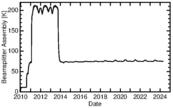 22 Apr 2024 - WISE is now in a 391 x 393 km orbit, down 8 km
in the month since 22 Mar 2024.
22 Apr 2024 - WISE is now in a 391 x 393 km orbit, down 8 km
in the month since 22 Mar 2024.

 22 Apr 2024 - WISE is now in a 391 x 393 km orbit, down 8 km
in the month since 22 Mar 2024.
22 Apr 2024 - WISE is now in a 391 x 393 km orbit, down 8 km
in the month since 22 Mar 2024.
22 Mar 2024 - WISE is now in a 398 x 402 km orbit, down 5 km since 26 Feb, losing about 6.1 km/month.
26 Feb 2024 - WISE is now in a 403x407 km orbit, down 5 km since 30 Jan 2024, losing about 5.6 km/month.
30 Jan 2024 - WISE is now in a 410x410 km orbit, down 5 km since 28 Dec 2023, losing about 4.6 km per month.
28 Dec 2023 - WISE is now in a 413x417 km orbit, down 5 km since 26 Nov 2023, losing about 4.75 km per month. The ISS reboosted to a 415x419 km orbit about 2 km above WISE.
26 Nov 2023 - WISE is now in a 419x421 km orbit, down 5 km since 22 Oct 2023, losing about 4.3 km per month. WISE is 2.5 km higher than the ISS.
28 Oct 2023 - WISE has reached its fall minimum temperature at 75.35 K, which is 0.23 K higher than last year.
22 Oct 2023 - WISE is now is a 424x426 km orbit, down 4.5 km since 25 Sep 2023, losing about 5 km per month. WISE is 7.5 km higher than the ISS so ISS-WISE conjunctions could be occuring before the end of 2023.
25 Sep 2023 - WISE is now in a 427x432 km orbit, down about 5.5 km since 6 Aug 2023, losing about 3 km per month.
06 Aug 2023 - WISE is now in a 434x436 km orbit, down 2.5 km since 9 Jul 2023 and 5 km since 14 Jun 2023, losing about 3 km per month. The ISS is at 416x417 km so things might get exciting around Feb 2024, assuming the ISS keeps reboosting to maintain its current altitude.
09 Jul 2023 - WISE is now in a 436x439 km orbit, down 2.5 km since 14 Jun 2023. The peak temperature appears to have been 77.96 K.
14 Jun 2023 - WISE is now in a 437x443 orbit, down 5 km since April 19. This is about 3 km per month. The beamsplitter assembly is now about 77.4 K, or just over the boiling point of nitrogen.
19 April 2023 - WISE is now in a 445x445 km orbit, down 4 km in a month.
02 April 2023 - WISE has reached its spring minimum temperature at 74.78 K, up 0.11 K from 2022. The orbit is now 446x449 km, down 1.5 km in 2 weeks.
18 Mar 2023 - WISE is now is a 447x451 km orbit, decaying about 3 km per month.
8 Feb 2023 - WISE is now in a 451x455 km orbit, decaying about 2 km per month.
28 Oct 2022 - WISE has reached it fall minimum temperature at 75.12 K. This is 0.14 K lower than in 2020. Also the orbit has decayed to 458x462 km altitude down from the 530 km at launch. The Sun is heating up the atmosphere creating more drag.
03 Jul 2022 - The summertime peak temperature was 78.02 K.
18 Dec 2021 - The intermediate winter peak in the WISE FPA temperature was 75.42 K, which is 0.15 K lower than last year's value. But the orbital decay rate has definitely increased as the Sun get more active.
18 July 2021 - The temperature of the WISE detectors is falling after reaching a peak of 78.72 K on 26 June 2021. This peak is 0.28 K lower than the peak in 2020. The orientation of the orbit with respect to the Sun has been quite stable because of the solar minimum which reduced the orbital decay and the decrease of the tidal torque from the Moon. But the Sun is now heating up so this reprieve will not last.
2 June 2021 - WISE has broken through the temperature of liquid nitrogen, reaching 77.60 on 5 Jun 2021. About 6 weeks until the peak temperature.
22 Mar 2021 - WISE appears to have reached its spring minimum temperature at 74.74 K. This is only 0.04 K higher than in 2020.
26 Dec 2020 - WISE seems to have reached its winter solstice maximum temperature at 75.57 K. This is 0.14 K higher than in 2019. The next minimum should be in March 2021.
25 Oct 2020 - WISE has reached it fall minimum temperature at 75.26 K. This is 0.13 K higher than in 2019.
08 Aug 2020 - WISE has cooled to 77.31 K, just below the temperature of liquid nitrogen.
04 Jul 2020 - WISE could be past the summer temperature peak. June 27 was at least a local maximum at 79.00 K.
23 Jun 2020 - The temperature is 78.91 K, the highest ever, and still rising 0.45 K/wk. Still about 3-4 weeks to the peak.
06 Jun 2020 - the temperature is above LN2 again and rising about 0.6 K/wk, with about 5-6 weeks to the summer peak.
23 May 2020 - the temperature is now higher than last year on this date [76.75 K] and rising faster [0.67 K/wk] with probably another 7-8 weeks to the summer peak.
20 Mar 2020 - WISE reached its annual minimum temperature today at 74.7 K.
21 Aug 2019 - WISE dropped into a safe mode (standby) at 9h UTC. Recovery was fast - about half a day, and WISE appears to be surveying normally. The temperature dropped a bit faster due to no power to the instrument for half a day, and it has continued to fall. The temperature is now 2 K below the peak.
12 Jul 2019 - The temperature appears to have peaked at 78.16 K on 5 Jul 2019. This is 1.26 K warmer than the 2018 peak.
28 Jun 2019 - The temperature is 78.03 K and the rate of rise has increased due to Moon avoidance maneuvers. But the solstice and June 3rd quarter Moon are past, so the rate of rise will fall, and the temperature should peak in a few weeks.
13 Jun 2019 - The temperature has broken LN2 at 77.59 K. The rate of rise is slowing though.
7 Jun 2019 - The temperature has reached 77.24 K, and is rising more than 0.5 K per week.
14 Dec 2018 - WISE has been in orbit for 9 years and it is entering its 6th year of observing since its re-activation. The orbit plane is now 27 degrees off nominal due to orbital decay, but the temperature is 75.15 K and operations up to the summer solstice of 2019 are planned.
29 Jun 2018 - The temperature appears to peak at 76.90 K, all of 0.46 K below liquid nitrogen boiling at 1 atm pressure. This is 1.03 K warmer than the 2017 peak.
2 Jun 2018 - The temperature has reached 75.98 K and is still rising. This warmer than any previous time during the re-activation.
3 Jul 2017 - The summer time temperature peak seems to have been 75.87 K which is 0.65 K warmer than 2016. The WISE HgCdTe detectors are still functioning at this temperature.
15 Jul 2016 - The summer time temperature peak seems to have come this week with the last two readings being 75.22 K. This is 0.45 K warmer than last year.
22 Mar 2016 - Reactived WISE has released its 2nd year of data! So means that community has access to another 5 million images and the sources detected on them.
14 Dec 2015 - WISE has been in orbit for 6 years! And it has started its 5th coverage of the sky since re-activation.
28 July 2015 - the summer time heat peaked on 18 Jul with the beamsplitter assembly at 74.77 K compared to the 74.4 K peak in summer of 2014.
21 May 2015 - WISE has discovered the most luminous galaxy in the Universe. More correctly, the most luminous galaxy on our past lightcone. 300 trillion solar luminosities.
26 Mar 2015 - 5 million NEOWISE-R images released!. The astronomical community now has access to the first year of NEOWISE-R observations. Single frames and single frame source detections are available.
14 Dec 2014 - Today is the 5th anniversary of the WISE launch. Happy Birthday WISE!
Also NEOWISE-R completed two full passes over the sky on 13 Dec 2014. Except for the strips missed in April, the whole sky has been covered 4 times, and a fifth coverage is starting.
25 Apr 2014 - W0855-0714 is only 2.2 parsecs away and has an effective temperature of 250 K, colder than ice. Kevin Luhman obtained Spitzer Space Telescope data on this source and found it has a proper motion of 8.1 arc-sec/yr, its distance is only 2.2 pc, it has both the reddest [3.6]-[4.5] color and the faintest absolute magnitude at 4.5 microns ever seen for a brown dwarf. For ages between 1 and 10 Gyr the mass is 3 to 10 Jupiter masses, so it is a free floating planet.
23 Apr 2014 - NEOWISE-R restarted full-time observing after flight software fixes to reduce the chance of a recurrence of the reaction wheel commanding problem that led to entry into safe mode on 3 Apr. There will be a sector of sky that will not get new coverage until October.
5 Jan 2014 - NEOWISE-R has discovered its first NEO, 2013 YP139. This is a potentially hazardous asteroid (PHA) with a radiometric diameter of 650 m, minimum orbit intersection distance (MOID) of 0.0033 AU, and has a velocity relative to the Earth at the MOID of 16 km/sec.
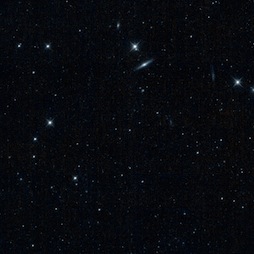 19 Dec 2013 - WISE obtained its "next light" images. Click on the
thumbnail at right for a full frame image taken showing NGC 4111.
Since the WISE reactiviation is being funded by the planetary science
division of NASA to search for asteroids, the mission is now called
NEOWISE-R, for Near Earth Object WISE Reactivation.
19 Dec 2013 - WISE obtained its "next light" images. Click on the
thumbnail at right for a full frame image taken showing NGC 4111.
Since the WISE reactiviation is being funded by the planetary science
division of NASA to search for asteroids, the mission is now called
NEOWISE-R, for Near Earth Object WISE Reactivation.
We hope to get astrophysics data analysis funding to redo the AllWISE catalog with the entire collection of data.
 3 Oct 2013 - WISE is zenith-pointed and the cool down begins.
Click on the thumbnail for a larger version of the plot.
This plot will be updated during the cool down.
3 Oct 2013 - WISE is zenith-pointed and the cool down begins.
Click on the thumbnail for a larger version of the plot.
This plot will be updated during the cool down.
As of 22 Oct 2013 the beamsplitter block temperature was 113 K and cooling at 2 K/day. With an expected asymptotic temperature of about 73 K the remaining cooling is 40 K and the time constant is 20 days.
On 30 Oct 2013 the temperature fell below 100 K, reaching 99.6 K. There are still 26 degrees to go and the time constant is still 20 days.
As of 7 Nov 2013 the temperature was 91 K falling 1 K per day.
As of 15 Nov 2013 the temperature was 85 K.
As of 21 Nov 2013 the temperature was 82 K.
As of 26 Nov 2013 the temperature was just under 80 K.
As of 2 Dec 2013 the temperature was just under 78 K dropping 0.3 K/day.
As of 10 Dec 2013 the temperature was 76.5 K dropping 0.12 K/day.
As of 5 Jan 2014 the temperature was 74.6 K dropping 0.05 K/day.
21 Aug 2013 - WISE is being reactivated to search for more Near Earth asteroids. The actual turning the transmitters back on and then turning away from the Earth to cool back down to 74 K should happen soon.
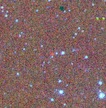
1 Aug 2013 - Asteroid 241527 Edwardwright, discovered by WISE on 8 Feb 2010, has been named for Edward L. (Ned) Wright, PI of WISE. According to the WISE data and the Near Earth Asteroid Thermal Model, it has a diameter of 3.5 km and an albedo (reflectivity) of 5%. It is a main belt asteroid with semi-major axis a=2.725 AU, eccentricity e=0.2003, and inclination i=7.22o.
In the picture on the right, the asteroid is the red dot in the center. This is a 3-color composite of the WISE 3.4, 4.6 and 12 μm bands as blue, green and red. The asteroid is much brighter at 12 μm so it appears red. Click on the image for a larger version.
This asteroid was seen in several "one-night stands" prior to the WISE discovery arc. But these observations, typically three frames taken within a total time span of an hour or less, were not enough to define the orbit. WISE observed the object 9 times over a 33 hour time span, and this gave an orbit good enough to get a preliminary designation (2010 CK9), ground-based followup two months later, and to connect to the previous short observational arcs. WISE also observed this asteroid 3 days before the discovery arc and also a few times later, so the total number of WISE observations is 18 spread over 106 hours.
These is no evidence for a light curve. The W3 channel with the highest signal to noise ratio gives a χ2 per degree of freedom of 11.1/17.
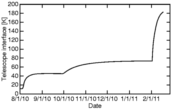
20 Sep 2012 - WISE responded to a wake up call today and sent down its stored housekeeping data. The telescope temperature is now 200 K compared to the 183 K (and rising) we saw on 17 Feb 2011 when we last listened. Click on the thumbnail of the temperature vs time graph for a bigger version. WISE is much warmer now than when it was surveying because it is in an inertial standby mode that keeps the solar panels pointed at the Sun but points at the Earth for half the orbit.
20 August 2012 - The AllWISE proposal to co-add all the WISE data has been accepted. This effort will give produce an all-sky catalog going about sqrt(2) deeper than the current all-sky catalog, a table of fluxes from the 30 or so individual individual frames on each source, and look for proper motion when combining the data taken six months apart. These data products will be produced late in 2013.
31 July 2012 - The NEOWISE Post-Cryo Preliminary Data Release is available at IRSA. This consists of the single frame images and a database of object detections on these frames during the 4 months Oct 2010 through Jan 2011. Since these data were taken for asteroid detection, they were processed using the preliminary pipeline, and they have not been co-added into tiles like the rest of WISE data.
27 June 2012 - ThE WISE 3-band Cryo Release is available at IRSA. This release gives a second pass over 31 percent of the sky. The telescope warmed up to 45 K, which saturated the 22 μm channel W4, and required a reduction in the integration time of the 12 μm channel so the W3 sensitivity is reduced by nearly an order of magnitude.
14 March 2012 - The WISE All-Sky Data Release is available at IRSA.
23 Aug 2011 - WISE has discovered a new class of stars, the Y dwarfs. Some of these stars appear to have temperatures less than 300 K, which is about room temperature. Y dwarfs show methane and water absorption like T dwarfs, but also show ammonia absorption. See Cushing et al. and Kirkpatrick et al..
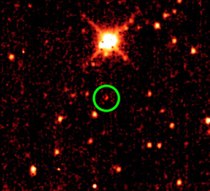
27 Jul 2011 - Connors etal (2011, Nature, 475, 481) have determined that the WISE discovered NEO 2010 TK7 is an Earth Trojan -- the first to have been found. WISE discovered 2010 TK7 after running our of hydrogen, so the discovery image at right is crowded with stars at 4.6 μm. The asteroid is circled in green. [Press Release]
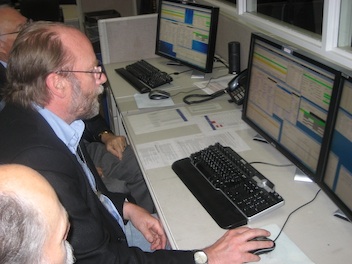
17 Feb 2011 - the last planned telemetry pass for WISE ended with turning off the transmitter at high noon in California: 20h UTC. The engineering data collected during this pass could be the last data from WISE, although it is still possible for WISE to receive commands and be roused from hibernation.
The picture at right shows Ned Wright sending the final command to turn off the transmitter.
07 Feb 2011 - the last batch of asteroid observations from WISE went to the Minor Planet Center, leading to the discovery of another NEO, pushing the total number of objects with WISE related objects with MPECS up to 184.
01 Feb 2011 - WISE is switched over to hibernation mode. There will be no more survey data. The last survey frame was taken on 1-Feb-2011 at 11:03:01 UTC. [ Press Release]
29 Jan 2011 - WISE added 2011 BY24 to its list of solar system discoveries.
09 Jan 2011 - WISE completed a double coverage of the sky today. Every pixel center on a 3 megapixel HEALpix grid has been observed in frames spanning at least a 5 month time interval, as of today.
04 Jan 2011 - WISE saw the solar eclipse. It was total for WISE even though the Moon's umbral shadow passed a bit North of the Earth. Of course WISE never looks at the Sun, but it did have to go on battery power.
14 Dec 2010 - WISE is one year old! Currently WISE is continuing to survey in its two short wavelength bands, and has now recovered 91% of the sky.
12 Dec 2010 - Mark Larsen, the systems engineer at Space Dynamics Lab responsible for the WISE payload, died today after a battle with cancer. On Nov 21, the International Astronomical Union renamed asteroid 243516 = 2010 CC7 as (243516) Marklarsen. This main belt asteroid was discovered by WISE on 6 Feb 2010.
30 Nov 2010 - WISE is still finding new asteroids. The latest is 2010 WS8 which just missed being a Near Earth Object, with a perihelion at 1.335 AU.
24 Nov 2010 - all of the backlogged data has been downloaded.
15 Nov 2010 - The backlog is finally being worked down, with 4.2 days of data being transmitted in the last 3 days. We should be back to normal by 21 Nov 2010.
06 Nov 2010 - The Delta II finally got off last night and I had a good view of it from UCLA. The space shuttle is delayed until NET Nov 30. Perhaps WISE can work down its backlog of onboard data, currently at 3 days of survey data.
04 Nov 2010 - The continued delays in the Delta II launch of Cosmo-SkyMed4 and the space shuttle, plus the TDRS problem, have pushed the backlog of data onboard to about 2 days survey data.
30 Oct 2010 - NEOWISE post-cryogen mission picked up another big dark NEO, and has a couple other possibilities waiting to be confirmed. But TDRSS problems and the imminent shuttle launch have led to a backlog of data onboard.
07 Oct 2010 - NEOWISE post-cryogen mission picked up an NEO with a period of almost exactly 1 year. In fact the synodic period is over 500 years.
29 Sep 2010 - WISE ran out of it hydrogen coolant. WISE is continuing to survey in its two short bands to determine diameters in the main asteroid belt and to search for NEOs. [Press Release] Two new potentially hazardous asteroids found by WISE were just announced. See for a list of all 170 Minor Planet Electronic Circulars based on WISE data to date.
31 Aug 2010 - WISE just added two new NEOs to its discovery total, both seen with the telescope warmed up to 45 K but the band 3 detector still cold.
10 Aug 2010 - On August 5, at about 09:00 UT, the WISE secondary hydrogen tank ran out of hydrogen. The WISE telescope is now warming up, but the primary hydrogen tank is still keeping the W3 and W4 arrays cold. On August 8 at 00:00 UT, the infrared emission from the warming telescope saturated W4, so no more 22 micron data will be obtained. As of today W3 is still working and still finding asteroids and comets. The primary tank may last for two more months.
29 July 2010 - Asteroid (234750) Amymainzer = 2002 NX69 has been named in honor of the PI of the NEOWISE effort for finding asteroids in the WISE data. WISE observed this asteroid in early March 2010, but it was discovered by NEAT on Palomar in 2002.
23 July 2010 - NEW color scheme for coverage maps: since 99.9% of the sky has been covered to 8 or more frames and the map was all pink, I have changed the color scheme and will now track the 16 or more frames coverage.
13 July 2010 - coverage update delayed by ground data processing. WISE continues to survey. UPDATE 15 July - ground data problem fixed, coverage at 99.2 percent.
11 July 2010 - WISE has recontacted the start of good survey data in the Southern part of the galactic sky.
1 July 2010 - WISE has recontacted the start of good survey data in the Northern part of the galactic sky. This means the usual 0.5-0.6 percent per day increase in coverage to a depth of 8 or more will slow down as coverage goes into increasing the 16x depth.
24 June 2010 - WISE has gotten through the solstice, and experienced the maximum expected exposure to Earthshine on June 19th while avoiding the first quarter Moon. There are now 119 NEOs, comets and Centaurs discovered by WISE.
30 May 2010 - WISE downloaded its millionth frame set last night. The millionth frame was taken at 29-May-2010 20:23:14 UTC centered at (l,b) = (90.33,14.53).
21 May 2010 - Due to the first quarter Moon leading to a planned survey backtrack, and the Space Shuttle in orbit plus a Delta 4 ready to launch from Florida leading to high demand on TDRSS, the reported survey progress today is rather small. But the data have been taken and are waiting in the 96 GByte flash memory built by SEAKR Engineering for downloading tonight.
30 Apr 2010 - WISE has started seeing eclipses over the South Pole. These will continue for the next 14 weeks.
15 Apr 2010 - WISE has covered more than 50 percent of the sky and discovered 50 NEOs, Centaurs and comets.
26 Feb 2010 - WISE has found 2010 DM56, an asteroid with a MOID of only 0.0068 AU.
25 Feb 2010 - WISE has found 2010 DG56, an asteroid with a retrograde orbit, a semi-major axis of 34 AU, and eccentricity 0.95. Probably a dead comet nucleus. UPDATE: Comet C/2010 DG56 (WISE)
17 Feb 2010 - Early Release Images from WISE were released today, showing
the large sky coverage that WISE has achieved in one month since
starting its survey. You can click on the thumbnails below to get the
highest resolution versions of these images, or you can go to the
WISE public web site to get a selection of different resolutions.
The images are, in order of increasing distance from the Sun:
Comet Siding Spring, NGC 3603, M31 and the Fornax cluster of
galaxies.
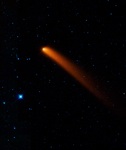
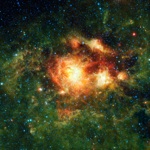
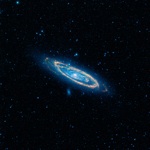
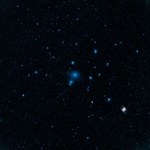
10 Feb 2010 - Minor Planet Electronic Circular 2010-C41 announces the discovery of a potentially hazardous asteroid 2010 CO1 by WISE. Its orbit and the Earth's orbit get as close as 3.3 million km (2 million miles). The period of this asteroid is 1.018 years. As a result it will be close to the Earth every year or so: 0.15 AU on 28 Feb 2010, and 0.09 AU on 04 March 2011, and it is worth keeping a watchful eye on.
08 Feb 2010 - Minor Planet Electronic Circular 2010-C23 announces the discovery of a comet by WISE: COMET P/2010 B2 (WISE).
22 Jan 2010 - Minor Planet Electronic Circular 2010-B33 announces the discovery of a fairly big Near Earth Object by WISE: 2010 AB78.
14 Jan 2010 - WISE officially started its survey today at 12:00 UT or 4 AM PST. The last scan calibration run on 11 Jan 2010 was quite successful, giving a consistent set of preferred scan rates that provide image quality that exceeds our requirement. In other news, an asteroid discovered by WISE has been designated 2010 AX58.
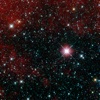
6 Jan 2010 - WISE first light image
is released at a
press conference during the
AAS meeting.
This is a very nice picture of a single WISE 47 arc-minute FOV in Carina,
centered at (l,b) = (279.21,-5.20).
It is an 8 second snapshot taken in staring mode. The bright star is V482 Car.
29 Dec 2009 - the cover is off. In Orbit Checkout continues.
16 Dec 2009 - The star trackers are on, and WISE is now in point standby mode pointing away from the Earth with the Sun on the solar panels. The aperture shade is cooling off dramatically since it is no longer seeing the Earth.
14 Dec 2009 - WISE launched at the opening of its window at 06:09:33
Update 07:07 PST: the circularization burn worked, the separation went OK,
and we are getting telemetry from WISE.
Update 07:29 PST: WISE has stabilized with the Sun on the solar panels,
and the vent valves have fired and appear to be open.
Update 21 Dec 2009: The image below shows WISE from Tujunga, about 222 km
from the launch site, about 4 minutes after liftoff.
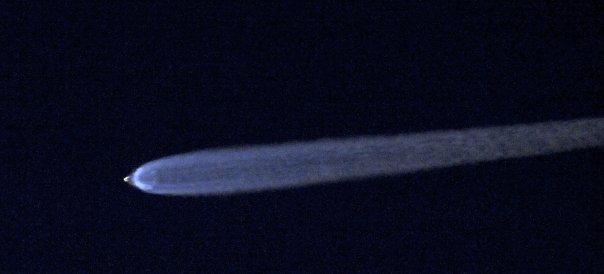
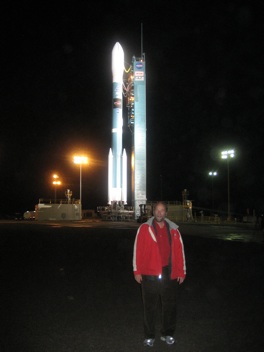 13 Dec 2009 - The Mobile Service Tower (MST) is now rolled back, so the
Delta II with WISE stands in the open on the launch pad. L-6 hours.
13 Dec 2009 - The Mobile Service Tower (MST) is now rolled back, so the
Delta II with WISE stands in the open on the launch pad. L-6 hours.
13 Dec 2009 - countdown has started with spacecraft power on.
Weather looks good for Monday except for ground fog which only
bothers the spectators, not the rocket.
Update: preparation continues with the disconnection of the
helium cooling flow. L-19 h.
WISE will
Simulated WISE images.
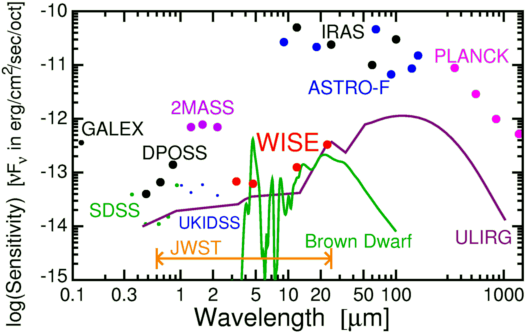
This figure shows the 5 sigma point source sensitivities of WISE and previous or planned all-sky surveys. The planned wavelength range for the JWST is indicated. The dot size shows the planned sky coverage. GALEX is a small Explorer (SMEX) which was launched by NASA in 2003, SDSS is the groundbased Sloan Digital Sky Survey, DPOSS is the groundbased Digital Palomar Observatory Sky Survey, ASTRO-F is the Japanese satellite, renamed Akari after launch on 22 Feb 2006, and Planck is the European CMB mission to be launched in 2009 which also includes a good sub-mm survey capability.
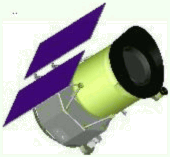
When DID WISE observe a given source?
WISE will make a preliminary release of data taken during the first half of the survey six months after the end of on-orbit data acquisition. For the current lifetime estimate of 10 months, and launch date of Dec 7, the first data release would be in April 2011. The final data release will be 11 months later in March 2012 according to current estimates.
The data products will include:| Mass: | 661 kg |
| Basic Design: | Three-axis stabilized. Body-fixed solar arrays. Fixed high gain antenna. |
| Power: | 301 W orbit average required, supplied by 2.4 m2 GaInP2/GaAs/Ge solar cells: 382 W EOL orbit average. |
| Telemetry: | Ku-band to TDRSS during polar passages. |
| Data Rate: | 23 GB per day (compressed) |
| Data Storage: | 96 GB |
| Propulsion: | None |
| PI: | Edward L. (Ned) Wright, UCLA Physics & Astronomy |
| Co-I's: | Science team |
| Project management: | JPL |
| Spacecraft: | Ball Aerospace |
| Instrument: | SDL |
| Detectors: | DRS and Teledyne (formerly RSC) |
| Cryostat: | Lockheed-Martin |
| Data analysis: | IPAC |
| EPO: | UC Berkeley Space Science Laboratory |